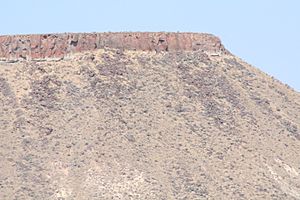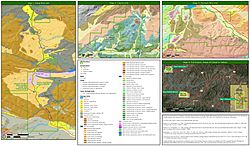Rattlesnake Formation facts for kids
Quick facts for kids Rattlesnake FormationStratigraphic range: Miocene-Late Pliocene |
|
|---|---|

The caprock in this photo (near Picture Gorge) is the ignimbrite layer
|
|
| Type | Sedimentary and igneous |
| Overlies | Mascall Formation, Columbia River Basalt Group |
| Area | John Day Valley |
| Thickness | 700 feet (210 m) |
| Lithology | |
| Primary | Fanglomerate, siltstone |
| Other | Tuff (ignimbrite) |
| Location | |
| Coordinates | 44°30′N 119°36′W / 44.5°N 119.6°W |
| Approximate paleocoordinates | 44°30′N 116°54′W / 44.5°N 116.9°W |
| Region | Oregon |
| Country | |
| Extent | eastern Oregon |
| Type section | |
| Named for | Rattlesnake Creek |
| Named by | J. C. Merriam |
| Year defined | 1901 |
The Rattlesnake Formation is a special type of rock layer found in Oregon, in the Western United States. It formed during the Miocene and Pliocene epochs, which were millions of years ago. You can find it along the John Day River Valley. This formation is important because it helps scientists learn about ancient Earth and the animals that lived there.
Contents
What is the Rattlesnake Formation?
This rock formation can be up to 700 feet (about 213 meters) thick. It is made of different kinds of rock.
- Fanglomerate: This is a type of conglomerate rock. It's made of rounded pebbles and larger rocks that were carried by fast-moving water, like in a fan-shaped deposit. The pebbles in the Rattlesnake Formation are made of basalt, chert, siltstone, diorite, and rhyolite. They are held together by a mix of sand from volcanoes.
- Siltstone: This is a fine-grained sedimentary rock made mostly of silt particles.
- Ignimbrite: This is a special kind of igneous rock that formed from a super-hot cloud of ash, pumice, and gas that erupted from a volcano. It's a type of tuff that was so hot it welded together. This ignimbrite layer is about 40 feet (12 meters) thick and stands out as a ridge or cliff.
How Old is the Rattlesnake Formation?
Scientists have used a method called radiometric dating to figure out the age of the rocks. They used the Potassium–argon method on the ignimbrite layer. This method measures how much of certain elements have changed over time. Based on this, the ignimbrite layer is about 6.4 million years old. This means the formation itself is from the Miocene to the late Pliocene epochs.
Ancient Animals Found Here
The Rattlesnake Formation is famous for the fossils of ancient mammals found within its layers. Many of these fossils were discovered below the ignimbrite layer, meaning they lived before that volcanic eruption happened.
Some of the amazing animals found include:
- Amebelodon sp.: An ancient elephant relative with shovel-like tusks.
- Mylohyus longirostris: An extinct type of peccary, which is a pig-like animal.
- Teleoceras fossiger: An extinct North American rhino that looked a bit like a modern hippo.
- Indarctos oregonensis: An extinct bear.
- Pliohippus spectans: An ancient horse, one of the first to have only one toe (hoof).
- Machairodus sp.: A type of saber-toothed cat.
- Hemiauchenia vera: An extinct camel relative.
- Vulpes stenognathus: An extinct species of fox.
- The earliest known fossils of modern-day beavers.
In the lower part of the formation, specifically in the fanglomerate rock, scientists also found remains of Pekania occulta. This was an ancient relative of the fisher, a type of weasel.
Images for kids


